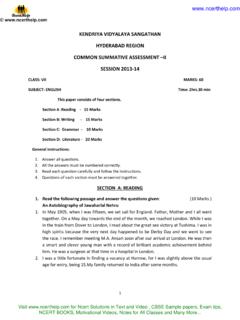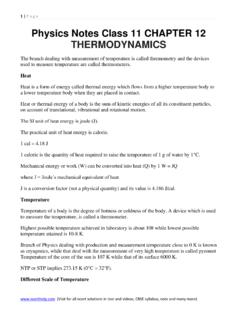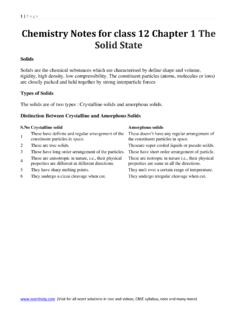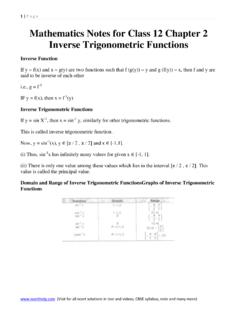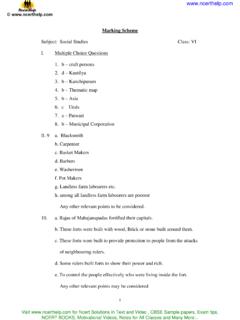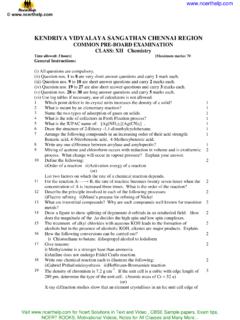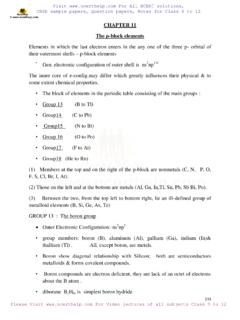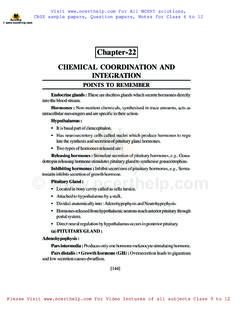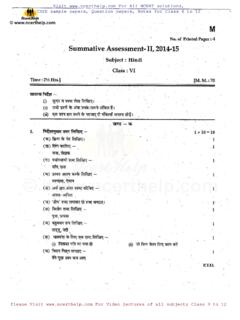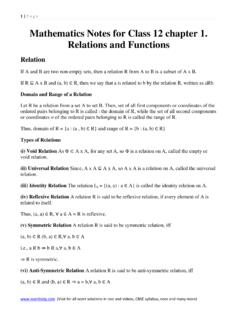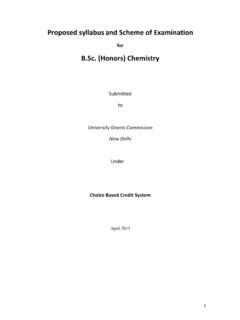Transcription of Chemistry Notes for class 12 Chapter 3 Electrochemistry
1 1 | P a g e (Visit for all ncert solutions in text and videos, CBSE syllabus, note and many more) Chemistry Notes for class 12 Chapter 3 Electrochemistry Electrochemistry is that branch of Chemistry which deals with the study of production of electricity from energy released during spontaneous chemical reactions and the use of electrical energy to bring about non-spontaneous chemical transformations. Importance of Electrochemistry 1. Production of metals like Na, Mg. Ca and Al. 2. Electroplating. 3. Purification of metals. 4. Batteries and cells used in various instruments. Conductors Substances that allow electric current to pass through them are known as conductors. Metallic Conductors or Electronic Conductors Substances which allow the electric current to pass through them by the movement of electrons are called metallic conductors, metals. Electrolytic Conductors or Electrolytes Substances which allow the passage of electricity through their fused state or aqueous solution and undergo chemical decomposition are called electrolytic conductors, , aqueous solution of acids.
2 Bases and salts. Electrolytes are of two types: 1. Strong electrolytes The electrolytes that completely dissociate or ionise into ions are called strong electrolytes. , HCl, NaOH, K2SO4 2. Weak electrolytes The electrolytes that dissociate partially (ex < 1) are called weak electrolytes, , CH3 COOH, H2CO3, NH4 OHH2S, etc. Electrochemical Cell and Electrolytic 2 | P a g e (Visit for all ncert solutions in text and videos, CBSE syllabus, note and many more) A cell of almost constant emf is called standard cell. The most common is Weston standard cell. Galvanic cell is also called voltaic cell. General Representation of an Electrochemical Cell Other features of the electrochemical cell are 3 | P a g e (Visit for all ncert solutions in text and videos, CBSE syllabus, note and many more) 1. There is no evolution of heat. 2. The solution remains neutral on both sides. 3. The reaction and now of electrons stops after sometime. Daniell Cell An electrochemical cell of zinc and copper metals is known as Daniell cell.
3 It is represented as By convention cathode is represented on the RHS and anode on the LHS. Function of salt bridge 1. It completes the circuit and allows the flow of current. 2. It maintains the electrical neutrality on both sides. Salt-bridge generally contains solution of strong electrolyte such as KNO3, KCL etc. KCI is preferred because the transport numbers of K+ and Cl-are almost same. Transport number or Transference number The current flowing through an electrolytic solution is carried by the ions. The fraction of the current carried by an ion is called its transport number or transference number. Thus. Transport number of cation. nc = (current carried by cation/total current) Transport number of cation. na = (current carried by anion/total current) Evidently nc + na = 1 Electrode Potential 4 | P a g e (Visit for all ncert solutions in text and videos, CBSE syllabus, note and many more) When an electrode is in contact with the solution of its ions in a half-cell, it has a tendency to lose or gain electrons which is known as electrode potential.
4 It is expressed in volts. It is an intensive property, , independent of the amount of species in the reaction. Oxidation potential The tendency to lose electrons in the above case is known as oxidation potential. Oxidation potential of a half-cell is inversely proportional to the concentration of ions in the solution. Reduction potential The tendency to gain electrons in the above case is known as reduction potential. According to IUPAC convention, the reduction potential alone be called as the electrode potential unless it is specifically mentioned. E red = E oxidalion It is not possible to determine the absolute value of electrode potential. For this a reference electrode [NHE or SHE] is required. The electrode potential is only the difference of potentials between two electrodes that we can measure by combining them to give a complete cell. Standard electrode potential The potential difference developed between metal electrode and solution of ions of unit molarity (1M) at 1 atm pressure and 25 C (298 K) is called standard electrode potential.
5 It is denoted by E . Reference Electrode The electrode of known potential is called reference electrode. It may be primary reference electrode like hydrogen electrode or secondary reference electrode like calomel electrode. Standard hydrogen electrode (SHE) Standard hydrogen electrode (SHE). also known as normal hydrogen electrode (NHE), consists of platinum wire, carrying platinum foil coated with finely divided platinum black. The wire is sealed into a glass tube. placed in beaker containing 1 M HCl. The hydrogen gas at 1 atm pressure is bubbled through the solution at 298K. Half-cell is pt H2 (1 atm) H+ (1 M) 5 | P a g e (Visit for all ncert solutions in text and videos, CBSE syllabus, note and many more) In SHE. at the surface of plantinum, either of (he following reaction can take place 2H+(ag) + 2e- H2G Reduction H2(g) 2H+(ag) + 2e- Oxidation The electrode potential of SHE has been fixed as zero at all temperatures. Its main drawbacks are 1.)
6 It is difficult to maintain 1 atm pressure of H2 gas. 2. It is difficult to maintain H+ ion concentration 1 M. 3. The platinum electrode is easily poisoned by traces of impurities. Hence, calomel electrodes are conveniently used as reference electrodes, It consists of mercury in contact with Hg2 Cl2 (calomel) paste in a solution of KCl. Electromotive Force (emf) of a Cell It is the difference between the electrode potentials of two half-cells and cause flow of current from electrode at higher potential to electrode at lower potential. It is also the measure of free energy change. Standard emf of a cell, Electrochemical Series It is the arrangement of electrodes in the increasing order of their standard reduction potentials. Standard Electrode Potential at 298 K 6 | P a g e (Visit for all ncert solutions in text and videos, CBSE syllabus, note and many more) 7 | P a g e (Visit for all ncert solutions in text and videos, CBSE syllabus, note and many more) Appications of Electrochemical Series (ECS) 1.
7 The lower the value of E , the greater the tendency to form cation. M Mn+ + ne- Metals placed below hydrogen in ECS replace hydrogen from di1 acids but metals placed above hydrogen cannot replace hydrogen from dil acids. 3. Oxides of metals placed below hydrogen are not reduced by H2 but oxides of iron and metals placed above iron are reduced by H2 SnO, PbO, CuO are reduced by H2 CaO, K2O are not reduced by H2 8 | P a g e (Visit for all ncert solutions in text and videos, CBSE syllabus, note and many more) 4. Reducing character increases down the series. 5. Reactivity increases down the series. 6. Determination of emf; emf is the difference of reduction potentials of two half-cells. Eemf = ERHS ELHS If the value of emf is positive. then reaction take place spontaneously, otherwise not. 7. Greater the reduction potential of a substance, oxidising power. ( F2 > Cl2 > Br2 > I2) 8. A negative value of standard reduction potential shows that it is the site of oxidation.
8 9. Oxides of metals having E red will be decomposed by heating to form O2 and metal. HgO (s) Hg(l)(1/2)O2(g) (E Hg2+/Hg = ) Nernst Equation The relationship between the concentration of ions and electrode potential is given by Nernst equation. For a electrochemical cell, Concentration of pure solids and liquids is taken as unity. Nernst equation and Kc At equilibrium 9 | P a g e (Visit for all ncert solutions in text and videos, CBSE syllabus, note and many more) Here, G is the standard Gibbs free energy change. Relationship between free energy change and equilibrium constant G = log Kc Concentration Cells (i) Electrode concentration cells Two hydrogen electrodes or different pressures are dipped In the same solution of electrolyte, (ii) Electrolyte concentration cells Electrodes are the same but electrolyte solutions have different concentrations, Conductance (G) It is the ease of flow of electric current through the conductor.
9 It is reciprocal of resistance (R). 10 | P a g e (Visit for all ncert solutions in text and videos, CBSE syllabus, note and many more) G = (1/R), units ohm-1 mhos or -1 Specific Conductivity (K) It is the reciprocal of specific resistance. Unit of cell constant is cm-1 or m-1. Specific conductivity decreases on dilution. This is because concentration of ions per cc decreases upon dilution. Molar Conductivity ( m) The conductivity of all the ions produced when 1 mole of an electrolyte is dissolved in V mL of solution is known as molar conductivity. It is related to specific conductance as m = (k x 1000/M) where. M = molarity. It units are -1 cm2 mol-1 or S cm2 mol-1. Equivalent conductivity ( m) The conducting power of all the ions produced when 1 g-equivalent of an electrolyte is dissolved in V mL of solution, is called equivalent conductivity. It is related to specific conductance as m = (k x 1000/N) where. N = normality . Its units are ohm-1 cm2 (equiv-1) or mho cm2 (equiv-1) or S cm2 (g-equiv-1).
10 11 | P a g e (Visit for all ncert solutions in text and videos, CBSE syllabus, note and many more) Debye-Huckel Onsagar equation It gives a relation between molar conductivity, m at a particular concentration and molar conductivity m at infinite dilution. m = 0m C where, b is a constant. It depends upon the nature of solvent and temperature. Factors Affecting Conductivity (i) Nature of electrolyte The strong electrolytes like KNO3 KCl. NaOH. etc. are completely ionised in aqueous solution and have high values of conductivity (molar as well as equivalent). The weak electrolytes are ionised to a lesser extent in aqueous solution and have lower values of conductivity (molar as well as equivalent) . ii) Concentration of the solution The concentrated solutions of strong electrolytes have SIgnificant interionic attractions. which reduce the speed of ions and lower the value of m. and eq. The dilution decreases such attractions and increase the value of m and eq.
